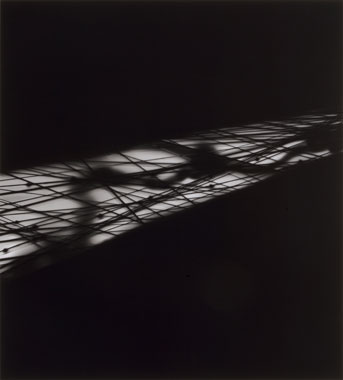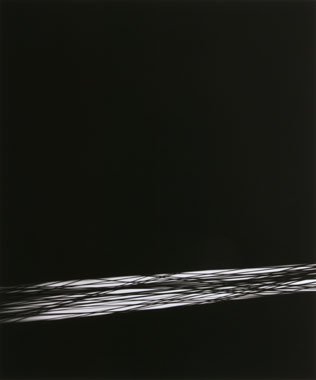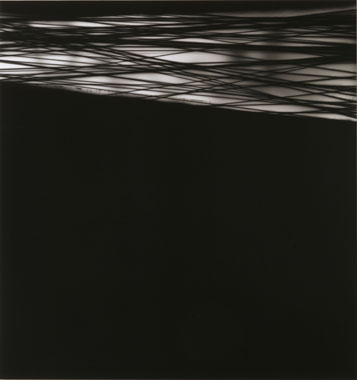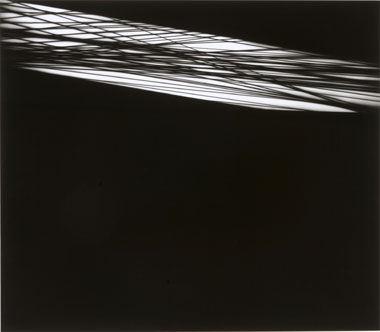Martina Corry showed eleven luminograms at the Golden Thread Gallery, as a part of the A Dark noise exhibition curated by Peter Richards, in October 2006.
She chose this mode of work during her Master of Fine Art Degree studies at the University of Ulster and during the subsequent years developed its subtle qualities. She is and has been a perfectionist. Dedicated to a mix of ideas that range from heroic modernism back to Renaissance and earlier paintings, her images grow out of spontaneity of hand and arm movement, paradoxically disciplined by a compositional order carefully chosen a priori. Tapes are placed where the light should not make a mark. It is in distance from the surface and possibly the speed and direction of the movement that the work is allowed to be spontaneous.
I asked her how she works: in a dark room?
All the works in the GTG show are created entirely in the darkroom. I worked under normal B/W safelight conditions for this body of work but have previously worked in the darkroom without any light other than the light source I am using to make my mark with. However, either way I cannot see the mark I have made until I have passed the photographic paper through the developer – I print my own work. I have a small darkroom and manage to print large sheets of photographic paper, which I buy in rolls up to 114.5cm/45inch wide.
I like the darkroom environment, its quietude, it really is my studio…
For this body of work I have been using fibre optics to work with. I combined this with the slightly lower-tech use of masking tape and card, which have always been used by photographers in the darkroom to perform dodging and burning tasks. Dodging and burning are ways of controlling the amount of light selected areas will receive.
I asked: The black on the image is the area exposed to the light?
Yes, the black areas have been exposed to light. In these works, sweeping the fibre optics across the surface of the photographic paper produces straight lines; at times I move the fibre optics away from the paper to create more ambiguous areas of shadow.
So the works are built up over a period of time. Where the image is white there has been no exposure to light.
The salient points for Corry’s art practice appear to be: light, time, camera-free photography, trace of gesture invisible at the time of making. In addition: the image is its own source and context, its cognitive force undiminished by not referring to the world outside of itself.
The upshot is a set of values that are sensitive to contemporary pressures, including the viewer’s self-image; however, the tenor of the Corry’s art is its contribution to the culture of freedom against a routine. If lens based media is a routine, she selects lens-free photography; if a socio-political context validates art routinely, she selects resistance to dispersal in surrounding contexts. Her art is no longer context-dependent. Each image forms a closed, performatively realized whole that ‘indicates’ relevant contextual and expressive factors from within. The pensive, sombre and thoughtful compositions elicit a melancholy that is more an invitation to reflection and contemplation than a manifestation of sadness or of depression of spirit. Such a shift is born from imagination, not from observation, which of course is already disabled by the invisibility of the mark made until the image is developed.
The resourcefulness of imagination is critically matched to a mental image of something that has not been perceived or present to the senses. In other words, the imagination is allowed to be a force of nature, not of culture. The artist, nevertheless, forges a skid into culture by a priori composition – the distribution of full and empty, the white sharp lines and large black areas, hard and soft, angled and flowing, active and contemplative.
To get there, Corry surrounds herself with darkness which she compares to silence. Indeed, the linear white drawings clustered in one part of the rectangle do appear as ‘noisy’. It is a noise associated with a birth, here with birth of light. Corry uses a new-born light, which exists only when she draws; it cannot be recorded in any other way, renewing and reoccurring as time moves on. A reminder of ‘not stepping into the same river twice’? The light as a pencil as a pen as a brush – galloping away after touching the sensitive paper – constantly loses its materiality after imprinting onto matter. Like a metaphor for a ‘dance of death’, the light renews itself in another moment, born again. The light in her hands becomes a confident paraphrase of self-development and experiment. It is a reminder of John Stuart Mill’s On Liberty, namely, his extolling the virtues of choosing one’s plan of life for oneself, not because it is the best of all, but because it is a person’s own. The sound of the new-born light is a call for personal courage and individual responsibility. This ethos may become a force to dwarf dependency on institutions and groups. These I see as the contemporary pressures to which Corry’s art practice responds.
Any emergence of creative ideas confronts some fears. The viewer’s self-image usually blocks such confrontations. By not offering mimesis to comfort the uncertainty of that new-born light, which has no history to lean on, the luminograms announce a possible change in the nature of something or someone. The change compensates for the insecurity of being. The images inspire liberation from the shackles of the past, a consequence of which is the transformation of aesthetic quality into a socio-political one. Does this sound too far-fetched? Well, consider the recent findings of cognitive neuroscience: there is evidence for overlapping but partly distinct neural systems for processing concrete and abstract concepts. During the processing of concrete concepts bilateral areas of the brain are active. Abstract concepts are processed almost exclusively by the left hemisphere. Our perception of anything depends on our capacity for action and thought, and on the two contradictory types of processing available to us: distinct and overlapping. The continuous flow between sensation and understanding validates the overlapping between something which looks nonpolitical but is by the virtue of an aesthetic function that embodies an ethics rooted in cognition.
If knowledge is what is both true and believed, I wonder if Corry’s philosophical standpoint is near so-called infinitism. Infinitism seems to propose an infinite series as a potential, while an individual selects consciously only what is connected to his or her need to know. Corry coaxes the viewer into a state of self-reflexivity utilizing the sparest formal means, some devilishly subtle (like the imprints of cellotape), to hold high the consciousness of perception.
I see Corry’s art practice as a glorious celebration of an individual holding his / her own in the world.
Slavka Sverakova is a writer on art.





